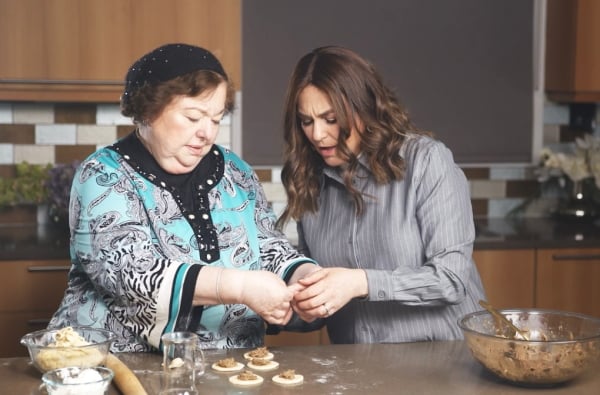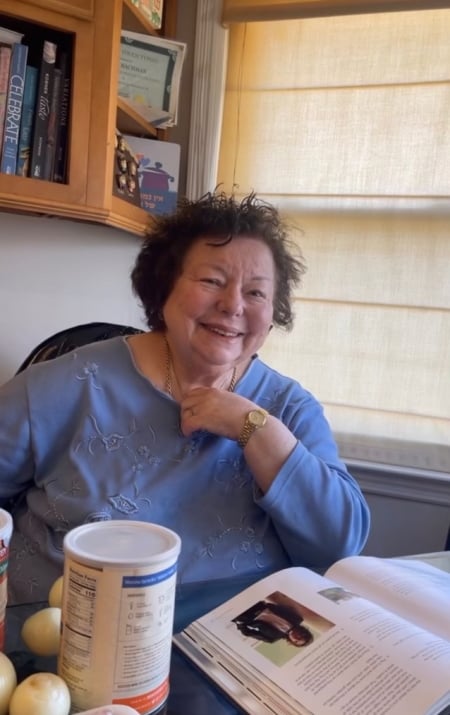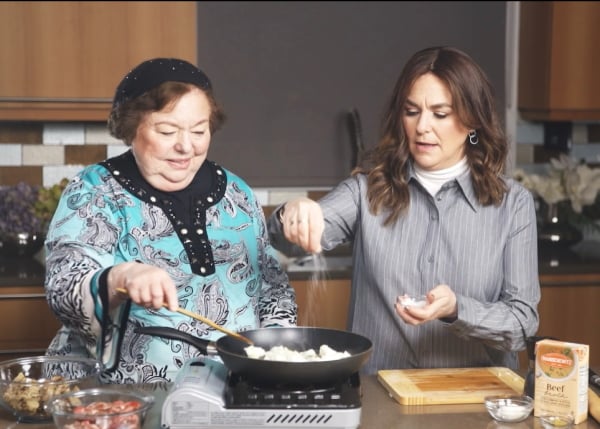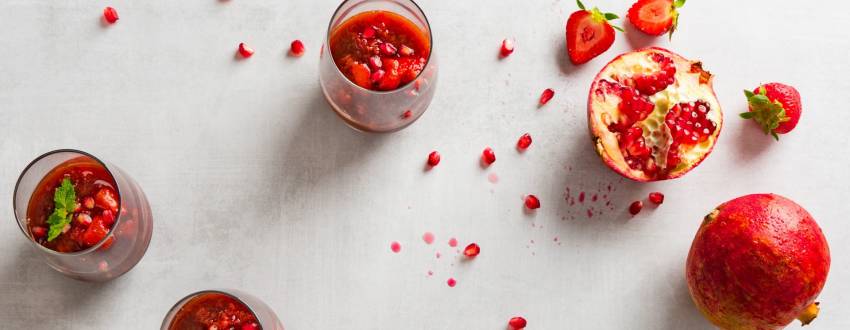Kosher.com just aired a new Sunny Side Up episode where Naomi was accompanied by a very special guest – Miriam Stein, a.k.a her mother! I interviewed Miriam to hear more about the recipe she makes on Sunny Side Up and to hear more about her background, culinary influences and inspirations. Like Naomi, Miriam is passionate about cooking and entertaining and is a wealth of knowledge! I had such a blast speaking with Miriam and hope you enjoy the full interview below!
Please note that this Q and A has been lightly edited for length and clarity.

DG: Thank you so much for speaking with me today! I know that you made kreplach with Naomi on Sunny Side Up. I would love to hear more about the origins of that recipe. Was it passed down from your family?
MS: I am very much a traditionalist, I love making old-fashioned food, like they made back in Poland. My parents came from Poland and both survived the Holocaust. My mother was from Vilna, and father was from Bialystok – real Jewish centers in those days. My mother was about 16 or 17 when the war broke out, so she didn’t know a lot about cooking. But she remembered what her mother used to do and how much time she used to spend in the kitchen with her. And my mother did the same. I think I like making kreplach and other foods because I think about spending time with my mother in the kitchen. And any time you spend with family – especially with a mother – is special. We had a very good relationship. It was just lovely. I don’t know whether I enjoyed the kreplach so much, but just the time that we had together, where we could patchke around in the kitchen and talk. She would tell me about her time in Poland and her parents. Neither of them survived the Holocaust. My mother and her sister were the only two survivors. I think it was the time we spent together that made it so special, and of course, the food was excellent – very tasty.
DG: Do you have any other recipes that were passed down from your family that you still make?
MS: My mother didn’t keep kosher, so she always came to my place to cook for yuntif. A couple of days before, she would come and help me make things, and she was also an excellent cook. I still use my mother’s recipe for honey cake. I make two cakes for the yamim tovim and serve it to our visitors over Sukkot. I still make stuffed gefilte fish heads for Rosh Hashanah and give them out to friends in the community so they can be yotzei the mitzvah of having them on the table. I also still make chicken soup, roasted potatoes, potato kugel and fleishig tzimmes with prunes, honey, carrots and chicken wings, similarly to how my mother did. The tzimmes gets nice and brown and yummy. People tell me they don’t like tzimmes. I say, “Have at least one carrot.” [laughs] “And then they ask for more.”
My mother also used to make fruit compote. In those days, they didn’t have all of the fancy creams and parve milks to make fancy desserts. In my parents’ household, we always had compote in the fridge, from one Friday to the next, based on whatever was in season – apple, pears, rhubarb… sometimes we would also have dried fruit. We had it with very little sugar. I still make compote, especially in summer. December, January and February are very hot in Australia, and March and April are still very warm.
I think there is a gene that runs in our family. Apparently, my grandmother’s mother was an excellent cook, from what my mother told me; I am a relatively good cook; and my brother’s also in the catering business in Sydney. Both of his daughters cook, and his granddaughter is a mini chef. She is an excellent cook for a young girl – she’s only 14! And both of my kids cook. It seems to run in our family [laughs].
DG: I hear that you’ve lived in a few different places. Which city’s cuisine did you like the best and why?
MS: My parents met straight after the war. When they were already talking about making Israel a Jewish state, my parents decided to go to Israel. My mother’s sister was married at the time, and her husband wanted to go as far away from Europe as possible. Australia was the furthest place they could go. So, they went to Australia, and my parents went to Israel. In Israel, my mother was very lonely, since she had been together with her sister during the whole war. So, when they got married, and they had happy times, they said, “Why should we be apart now?” So, we came to Australia in 1955. We were like one family for many years. We were always together. We had a very good life in Australia.
A big influence on my cooking was Israeli salad – any sort of salads. I love Israeli salad. It was also all we could get in Israel at the time. In 1948 and 1949, when we lived there, food was very rationed in Israel.

DG: When your family moved to Australia, were there any Polish or Israeli dishes that your parents continued to cook?
MS: It’s funny – if we wanted to buy Israeli food, like hummus and tahini, we had to go to the Arab areas. They weren’t available so readily like they are now. Hummus and tahini you can buy everywhere now. Lettuce, tomatoes, and cucumbers you could of course get everywhere. But the little specialties, like falafel, hummus, and tahini, were harder to get in those days.
Because of this, we mostly ate Polish-inspired food when I was in Israel: potatoes, chicken, meat, fresh fruit… whatever was available at the time. We were much more influenced by Polish and eastern European cuisine. Cabbage rolls were on our menu regularly. We had potatoes, onions… all those sorts of eastern European foods. We also had a lot of salads. The only pasta we used to have was fine lokshen in the soup on Friday night. And it was a treat when we had kreplach. We continued to eat these foods in Australia.
DG: When your family moved to Australia, did what your family cooked change at all?
MS: No, it was pretty much the same.
In the 1960s and 1970s, we had a lot of homemade gefilte fish, homemade pickled herring, especially in our shul in Bondi. We have moved to a much more secular way of eating – nowadays, you don’t have a Jewish event without sushi. We used to have gefilte fish or fried fish, but no one really makes that anymore.
DG: As you got older, did your cooking take on any Australian influences?
MS: We love lamb. Our lamb is wonderful. It used to be relatively inexpensive – now the prices have become very expensive. We love lamb chops. We never had lamb in Israel.
We are also much more into fusion cooking now. If I have leftover chicken from Shabbos, I’ll make a Chinese stir fry with it. I’ll cook up some fresh vegetables, put them in the stir fry, make a sauce, and cut up the chicken. That’s just one example.
My husband, Jack, was born in Australia. His father was an Israeli who came to Australia in 1928 and his mother was English. He was brought up much more Australian I was. As a matter of fact, Jack is one of the few friends that we have in our circle who is actually born in Australia – most of us were born in Europe after the war. He would think nothing of having a steak or sausages for breakfast. I couldn’t understand how he could have steak for breakfast with eggs. He couldn’t understand how we could have herring for breakfast!
Pizza has also become very popular in Australia over the years, starting in the 1970s. We were influenced by the Italian migration – Italian restaurants popped up everywhere.
Practically every suburb in the New South Wales state has a Chinese restaurant. (There was a large wave of Chinese immigration to Australia starting in the 1840s and 1850s with the Gold Rush.) They have Chinese dishes and they also have Australian dishes, for those who aren’t game to try something new.
DG: I hear that you ran a Pesach program for close to 30 years. That’s amazing! I would love to hear more about this. How did this idea start for you, and what was the experience like?
MS: We were sitting with some friends on a Sunday afternoon, while all of our kids were in Bnei Akiva camp. That week, the Jewish newspaper had run an advertisement to “Come and book a Hawaiian Pesach.” I rang up, and the price was exorbitant – certainly above our price range. We were talking with our friends, and I brought this up. One of my friends said that her parents used to run a Pesach program back in the 30s and 40s out of a small hotel. This conversation was in December or January, and Pesach was three months away. Jack sort of got stuck into it to see if we could run our own Pesach program. Our friends said, “Why don’t you try?”
Jack got very busy for two weeks trying to find a hotel that would allow us to take over. One person wanted to take a chance. That’s what we did the first year. We never, ever thought this would continue for 28 years! We stayed in that hotel for a few years, and then we switched hotels several times over the years.
We made some wonderful friends and also met people from overseas with whom we’ve been in touch for years.
DG: What kinds of recipes did you make for the Pesach program? Were any of them influenced by your childhood or upbringing at all?
MS: With Pesach, as you know, it’s different. Now there is a lot more to choose from. One year, Naomi and her family came to Pesach, and they brought ice cream cones for Pesach that were non-gebrochts, and people couldn’t believe it. But now, I’ve been to a couple of the American Pesach programs, and they have rolls that look like bread, and things that look like hot dog rolls. We didn’t have that available in those days. We were very limited, and we tried to please everybody. A lot of things we made non-gebrochts, like most of our cakes. But we did have matzo balls for those that wanted. And we made matzo brei for those that wanted… We made old-fashioned food, good things.

DG: It’s so interesting that Naomi has followed in your footsteps and has a Pesach catering business and cookbook of her own! What does this mean to you that Naomi is now following a similar career path to you?
MS: I feel like a celebrity! You wouldn’t be interviewing me if it wasn’t for Naomi! Thank G-d, I schep a lot of nachas when Naomi and I go out sometimes, and people come over and say, “Are you Naomi Nachman?” and she says, “Yes, thank you for coming over!” They are always so excited to meet her. And it’s so nice that she mentions us in the recipes in her cookbook.
DG: Thank you so much for taking the time to speak with me. Do you have anything else to add?
MS: Some people find cooking a chore. I don’t. I enjoy and feel very comfortable being in the kitchen. So many people are so happy to taste my food. For me personally, I feel it’s my artistic flair coming out. Some people draw, some people paint, some people are dressmakers. I like to decorate my food and put it nicely on the table.
I have a friend who passed away who used to say, “It’s not what you serve, it’s how you serve it.” Your eyes see it first before you can taste it. The food has got to look presentable, and then you get the added bonus of when it tastes nice.





